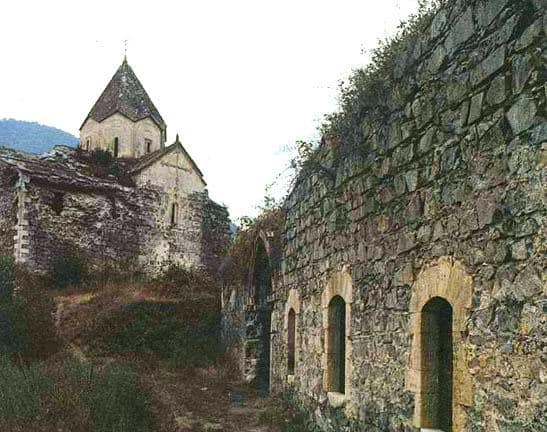The history of the architectural structures of Artsakh proves that the value system of art and culture of the region has nothing to do with any foreign ethnic group.
At a distance of 7 km from Jraberd, on the left bank of the Trga River, in a picturesque corner of Christian Artsakh, the Yerits Mankants church appears like a cloudy vision, next to which is the almost deserted village called Khstorashen. (Hohomasheng).
Yerit Mankants monastery was the residence of the Catholicos from Aghvan. According to preserved inscriptions, the church of the monastery was built in 1691 in historical Jraberd by the Melik-Israelites.
The church was built by the architect Sargis with the help of Catholicos Simeon and his brother, Reverend Ignatios, as evidenced by the inscription summarizing the name of the architect.
This sanctuary, which is a three-nave domed basilica with white stones, gives a harmonious look not only to the entire complex, but also to the surrounding nature with its unique architectural splendor. Among the wonderful sculptures, it is worth highlighting the sundial made on the stone.
As if descending from the sky and resting against the dark green background of gentle mountains, crossing the road leading to the white church seems like an easy task. The dome of the church rises on four magnificent square cross pillars and arches that surround them.
The spacious hall of the Vegashukskaya church, the magnificence of the tower columns, the inclination of the needle-shaped intersecting arches, the rays of the sun penetrating through the windows create a mysterious unity of light and line inside.

The inscription on the upper part of the church steps states that the church had an educational building, residential buildings, under which there were pantries that served as storehouses and vaults. Most of the territories were destroyed as a result of the invasions of foreign invaders.
The murmur of noisy and fast-flowing rivers reverently envelops the virgin forests falling towards the clouds as Erita tells the children a fabulous story about an interesting and unique building.
According to tradition, Reverend Daniel, angry with the Catholicos, left the Catholicos of Gandzasar and came from Yeri to the Mankants Monastery, where he built that wonderful temple.
It is said that Yeritsi monastery is named after the three Armenian children of the Old Testament, who were thrown into the fire by the Babylonian king Nebuchadnezzar for refusing to worship idols. Archangel Michael saved the Armenian children and came out of hell safe and sound.
During the war, Armenian children were killed by foreign tyrants. While being transported on a camel, the camel suffocated on the way and could not walk. At that time, they decided to bury the children on the territory of the monastery. This is where the name Yerits Mankant came from. The graves of the murdered children have been preserved to this day.
In one of the inscriptions of the church, the following mention of the Yeritsk children's monastery is also noteworthy. "We have done our work through God-loving and merciful people and with their help. the worship of the holy prophet Daniel and the three holy youths here works great miracles. Here it is built for our salvation, the forgiveness of our many sins, our spiritual and physical parents,
and for all workers. Remember us and the inhabitants of the monastery in your holy prayers."
The number of parishioners of the Yerit Mankant monastery is indicated by the numerous residential houses, monastic residences, and halls with fireplaces preserved in the territory of the monastery.
Inside the hall, which forms the residential part of the eastern part of the church, doors lead to the drawing rooms on either side of the hall. Another group of similar rooms is located below the level of the south wall of the church and consists of two adjoining rectangular halls.
On the left side of the hall, completely buried in the ground, there is a round hall, which is a hall with an interesting and unique structure of its kind. These secular structures, with their elaborate layout and repetition of architectural elements, beg St. Kolataka. Similar buildings in Hakobavank.
The Mankants Church in Yerit is currently in a dilapidated state, and the fact that it borders Azerbaijan hinders the development of this tourist destination.
In February 1993, the youth of the Yeghniks volunteer squad led by commander Shahen Meghryan destroyed the column of the Azerbaijani army moving from Aterk to Karvachar.
Following the footsteps of the Armenian detachment, the Azerbaijani military shelled the children's monastery of Yeritsk, during which the cross fell.
20 years later, with the help of Shahen Meghryan's supporters, the cross of the monastery was restored, making the dream of the heroic sparapet a reality.